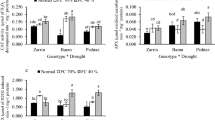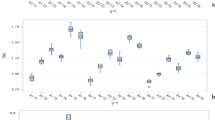Abstract
Homobrassinolide (BR) was applied either as a seed treatment or foliar spray to two contrasting wheat varieties, viz. C306 (drought tolerant) and HD2329 (drought susceptible), to examine its effects on plant metabolism and grain yield under irrigated and moisture-stress/rainfed conditions. BR application resulted in increased relative water content, nitrate reductase activity, chlorophyll content and photosynthesis under both conditions. BR application also improved membrane stability (lower injury). These beneficial effects resulted in higher leaf area, biomass production, grain yield and yield related parameters in the treated plants. All the treatments were significantly better than the untreated control. Generally, 0.05 ppm either as a seed treatment or foliar spray was more effective than the 0.01 ppm treatment. The drought-tolerant genotype C306 showed more response to BR application under moisture-stress/rainfed condition than HD 2329. Increased water uptake, membrane stability and higher carbon dioxide and nitrogen assimilation rates under stress seemed to be related to homobrassinolide-induced drought tolerance.
Similar content being viewed by others
References
Arnon DI (1949) Copper enzymes in isolated chloroplasts: Polyphenol oxidase in Beta vulgaris. Plant Physiol 24: 1–15
Braun P and Wild A (1984) The influence of brassinosteroid, a growth-promoting steroidal lactone on development and carbon dioxide fixation capacity of intact wheat and mustard seedlings. In: Sybesma C (ed) Advances in photosynthesis research, Proc 6th Congr Photosynthesis 3: 461–464 Martinus Nijhoff, The Hague
Braun P and Wild A (1984) The influence of brassinosteroid on growth and parameters of photosynthesis of wheat and mustard plants. J Plant Physiol 116: 189–196
Cerana R, Bonetti A, Marre MT, Romani G, Lado P and Marre E (1983) Effects of brassinosteroid on growth and electrogenic proton extrusion in Azukibean epicotyls. Physiol Plant 59: 23–27
Cerana R, Spelta M, Bonetti A and Lado P (1985) On the effects of cholesterol on H+ extrusion and on growth in maize root segments: Comparison with brassinosteroid. Plant Sci 38: 99–105
Fujii S, Hirai K and Saka H (1991) Growth regulating action of brassinolide in rice plants. In: Cutler HG, Yokota T and Adams G (eds) Brassinosteroids. Chemistry, bio- activity and application, pp 306–311. American Chem Soc, Washington DC, USA
Grove MD, Spencer FG, Rohwedder WK, Mandava NB, Worley JF, Warthen JD Jr., Steffens GL, Flippen-Anderson JL and Cook JC Jr (1979) Brassinolide, a plant growth-promoting steroid isolated from Brassica napus pollen. Nature 281: 216–217
Hamada K (1986) Brassinolide: Some effects for crop cultivation. Conf Proc Int Seminar Plant Growth Regul Tokyo Japan, Oct 15, 1985
Hiscox JD and Israelstam GF (1979) A method for the extraction of chlorophyll from leaf tissue without maceration. Can J Bot 57: 1332–1334
Iwahari S, Tominaga S and Higuchi S (1990) Retardation of abscission of citrus leaf and fruitlet explants by brassinolide. Plant Growth Regul 9: 119–125
Kalinich JF, Mandava NB and Todhunter JA (1985) Relationship of nucleic acid metabolism to brassinolide-induced responses in beans. J Plant Physiol 120: 207–214
Kulaeva ON, Burkhanov EA, Fedina AB, Khokhlova VA, Bokebayeva GA, Vorbrodt HM and Adam G (1991) Effect of brassinosteroids on protein synthesis and plant cell ultrastructure under stress. In: Cutler HG, Yokota T and Adams G (eds) Brassinosteroids. Chemistry, bioactivity and application, pp 141–155. American Chem Soc, Washington DC, USA
Kumura A, Ishii R, Luo BS, Adachi M, Hamada K and Fujita F (1989) Methods for increasing the yield of crops. Canadian Patent CA 126580 72 p
Mai YY, Lin JM, Zeng XL and Pan RJ (1989) Effect of brassinolide on the activity of nitrate reductase in rice seedlings. Plant Physiol Commun 2: 50–52
Mandava NB and Thompson MJ (1983) Chemistry and functions of brassinolide. In: Nes WD, Fuller G and Tsai LS (eds) Proceedings of the Isopentenoid Symposium, pp 401–431. Dekker, New York
Parkinson KJ, Day W and Leach JE (1980) A portable system for measuring the photosynthesis and transpiration in graminaceous leaves. J Exp Bot 31: 1441–1453
Petzold U, Peschel S, Dahse T and Adams G (1992) Stimulation of C14-sucrose export in Vicia faba plants by brassinosteroids, GA3 and IAA. Acta Bot Neerl 41: 469–479
Premchandra GS, Saneoka H and Ogata S (1990) Cell membrane stability, an indicator of drought tolerance as affected by applied nitrogen in soybean. J Agric Sci (Camb) 115: 63–66
Sasse JM (1985) The place of brassinolide in the sequential response to plant growth regulators in elongating tissue. Physiol Plant 63: 303–308
Schilling G, Schiller C and Otto S (1991) Influence of brassinosteroid on organ retention and enzyme activities of sugarbeet plants. In: Cutler HG, Yokota T and Adam G (eds) Brassinosteroids. Chemistry, bioactivity and applications, pp 208–219. Am Chem Soc, Washington DC, USA
Shen XY, Dai JY, Hu AC, Gu WL, He RY and Zheng B (1990) Studies on physiological effects of brassinolide on drought resistance in maize. J Shenyang Agric Univ 21: 191–195
Takematsu T, Takenchi Y and Koguchi M (1983) New Plant growth regulators: Brassinolide analogues, their biological effects and application to agriculture and biomass production. Chem Regul Plants 18: 2–15 (In Japanese)
Takeno K and Pharis RP (1982) Brassinolide-induced bending of the lamina of dwarf rice seedlings: An auxin mediated phenomenon. Plant Cell Physiol 23: 1275–1281
Wada K, Marumo S, Mori K, Takatsuto S, Morisaki M and Ikekawa N (1983) The rice lamina inclination promoting activity of synthetic brassinolide analogues with a modified side chain. Agric Biol Chem 47: 1139–1141
Weatherley PE (1950) Studies in the water relations of cotton plants. I. The field measurement of water deficit in leaves. New Phytol 49: 81–97
Yand ZS, Shi GA and Jin JH (1992) Effect of epibrassinolide and triadimefon on winter wheat yield and its physiological response. Acta Univ Agric Boreali Occidentalis 20: 47–50
Yokota T and Takahashi N (1986) Chemistry, physiology and agricultural applications of brassinolide and related steroids. In: Bopp M (ed) Plant growth substances, pp 129–138. Springer-Verlag, Berlin/Heidelberg
Author information
Authors and Affiliations
Rights and permissions
About this article
Cite this article
Sairam, R.K. Effects of homobrassinolide application on plant metabolism and grain yield under irrigated and moisture-stress conditions of two wheat varieties. Plant Growth Regul 14, 173–181 (1994). https://doi.org/10.1007/BF00025220
Received:
Accepted:
Issue Date:
DOI: https://doi.org/10.1007/BF00025220




